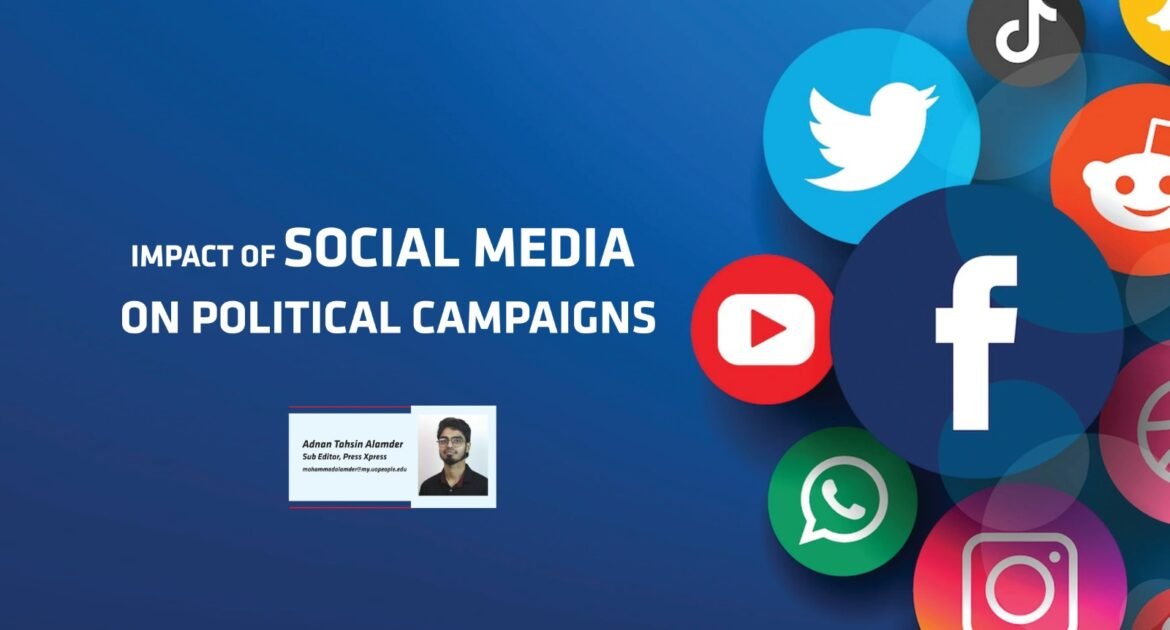In today’s digital age, social media platforms have become an essential tool for political campaigns. With the ability to reach a large audience, engage with voters, and shape public opinion, social media has transformed the way politicians run their campaigns. The impact of social media on political campaigns is undeniable and has been a hot topic of discussion in recent years. Social media have influenced political campaigns, including its effects on voter behavior, political communication, and campaign strategy.
You can also read: Female world leaders: Politics of women empowerment in numbers
There is also a role of social media in shaping the political discourse, spreading misinformation, and amplifying political polarization. It is important to recognize the power and influence of social media in shaping our political landscape. While social media has the potential to connect politicians with voters and promote democratic participation, it also raises significant concerns about the role of technology in politics. Ultimately, the impact of social media on political campaigns will continue to evolve as new platforms emerge and as society grapples with the implications of digital technology on our political institutions.
HOW SOCIAL MEDIA IS SHAPING THE WORLD?
According to the latest data from Datareportal’s January 2023 global overview, the growth of social media has continued to rise, with over half of the world’s population (59%) now using social media. Within the last 12 months, 137 million new users have joined social media, bringing the total number of social media users worldwide to 4.76 billion. On average, people spend 2 hours and 31 minutes daily using social media.
In 2021, TikTok experienced rapid growth, with a 142% increase year over year. This resulted in TikTok ranking as the sixth most-used platform for the first time in July 2022. As of data found in January 2023, TikTok remains in the sixth position.
The number of social media users globally grew from 4.2 billion in January 2021 to 4.62 billion in January 2022, representing a 10.1% year-over-year increase. However, the growth rate for January 2023 was more modest, with a 3% increase or +137 million users.
An analysis of regional use of social media shows a wide variation in social media penetration. In the report, the rate for Eastern Asia is 72%, followed by North America and Southern America with 74% each. Northern and Western Europe share the highest social media penetration rates at 84%. In contrast, social media usage is lower in Southern Asia (41%), Western Africa (13%), and Middle Africa (7%), compared to the others.
Politicians globally are increasingly using social media platforms to connect with their followers and promote their campaigns, according to a 2015 study by researchers Pablo and Thomas. In the past, political communication relied mainly on traditional methods like physical visits to voters, one-to-one interaction with candidates, and advertisement through banners, festoons, etc., which were considered crucial for positive feedback.
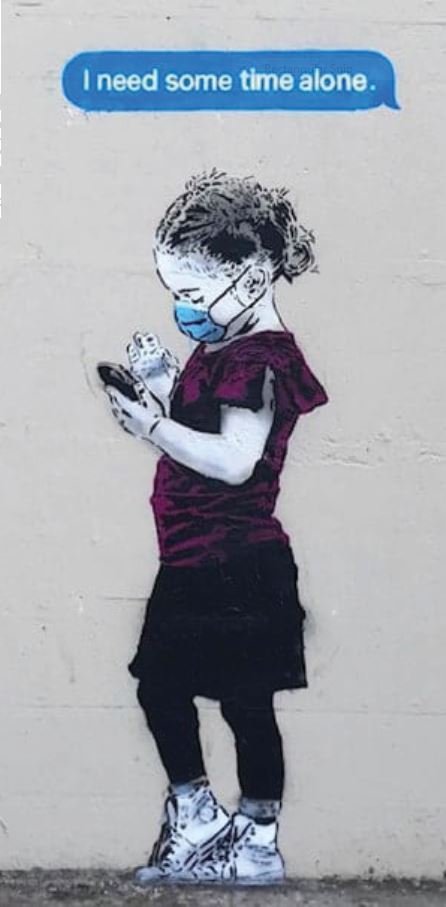
Politicians have begun incorporating digital campaigns into their political communication strategies due to the rise of social media and digital communication. While traditional methods are still relied on, social media platforms like Facebook, Twitter, and Instagram allow politicians to communicate with a broader audience and save time and effort. Moreover, digital campaigns also provide a platform for politicians to quickly counter negative propaganda and misinformation, and they are cost-effective compared to traditional methods as they save money on printing materials and instead invest in digital advertising.
SOCIAL MEDIA’S IMPACT ON WORLD POLITICS
Social media has played a crucial role in major protests and social movements across the globe, including the Arab Spring and the anti-corruption movement in India. Social media platforms such as Facebook and Twitter have empowered revolutionaries and activists, enabling them to connect with like-minded individuals and mobilise mass protests. In India, the 2012 Delhi gang rape case and Anna Hazare’s anti-corruption movement gained significant momentum through social media platforms.
Social media has been adopted by political parties worldwide, with Indian politicians from the Congress, BJP, and AAP following in the footsteps of Obama, who extensively used social media as a game-plan to achieve victory in his 2008 election victory in America. Indian Prime Minister Narendra Modi was among the first Indian politicians to set up his personal website and has created accounts on Twitter, YouTube, Facebook, Google+, and most of the other social media channels.
In India, out of a population of 1.2 billion, around 150 million people are active users of various social media and email platforms, with 71 million Facebook users and 20 million Twitter account holders. Each of these users acts as a socio-political influencer on three to five adults on average. This makes the size of the social media influence networks a minimum of 300 million voters, a considerable number.
YES WE CAN: OBAMA CHANGES THE GAME
In the lead-up to the 2008 election, Barack Obama revolutionised the use of social media in political campaigns. By utilising various social networking sites such as Facebook, YouTube, Twitter, Flickr, MySpace, Digg, Podcasts, and many others, he was able to connect directly with his supporters, bypassing traditional media. Obama’s social media team also used crowdsourcing to engage thousands of supporters in creating and distributing additional content. The official website, barackobama.com, hosted a plethora of materials that individuals could download and use to spread the message and organise volunteers.

Obama’s use of social media allowed him to raise awareness and financial support for his campaign. He was able to save over a hundred million dollars in TV ad spending by spreading his message through social media.
He relied on micro-donations from hundreds of thousands of supporters rather than big-ticket donations from high net worth individuals.
The official account of Barack Obama on Twitter is @ BarackObama. He used this platform to promote legislation and support for his policies, respond to the public regarding the economy and employment, and engage in debates on Twitter.
His account became the third to reach 10 million followers in September 2011, and as of March 21, 2023, he has 133 million followers, making him the owner of one of the most followed Twitter accounts.
Although both Obama and his Republican adversary Mitt Romney were active on Twitter, the Pew Research Center determined that only about 13% of American adults had joined the site.
Thus, Twitter’s impact on the election was only “one slice of an enormous communication effort.” Obama’s success cannot be attributed solely to his use of social media, as Twitter was the most popular social media app during this time and saw tremendous growth in the period from 2007 to 2010. Obama has been noted to have 5,000 times as much social media influence as United States Senator Mitt Romney, according to discussants on the PBS NewsHour. However, The Hill revealed that Obama has 12 times as much influence on social media.
BREXIT ISSUE AND CAMBRIDGE ANALYTICA SCANDAL
According to media analyst Tim Seaton, long-term anti-EU reporting and the demonisation of foreign nationals and the working class in mainstream media could have made the public more susceptible to pro-Brexit arguments. He also noted that social media played a much more prominent role in the campaign and the vote than in previous UK elections, and was highly influential in shaping voters’ opinions. Social media platforms, driven by popularity, enable users to “get more of what you like” while avoiding exposure to differing viewpoints.
A study conducted by Llewellyn and Cram indicated that the overall use of “leave” hashtags was greater than “stay” hashtags, even though “stay” equated to the largest percentage.
Yuriy Gorodnichenko, a presidential professor of University of California, analysed the role of social media agents, including real human users, bots, and algorithmdriven social bots, and found that Twitter was known for spreading fake news.
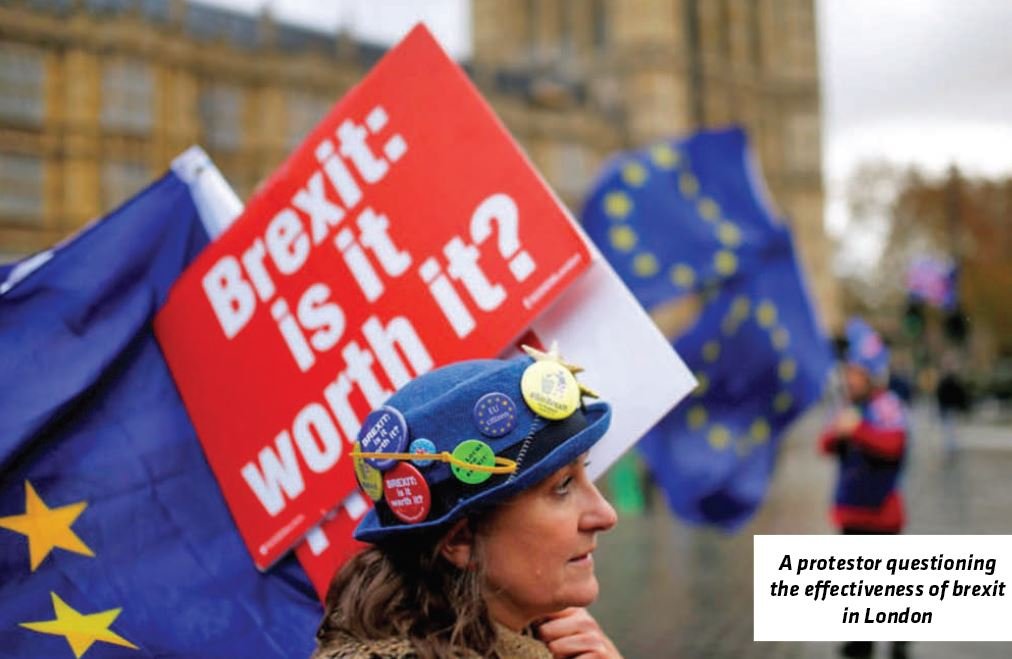
However, others claim that the sentiment results always indicated a likely “Leave” result and that the outcome was not solely due to bots or propaganda systems. Instagram also played a significant role in the referendum, although it was less direct than Twitter and not as noticed.
Moreover, the Cambridge Analytica scandal was a major controversy involving the use of Facebook user data to influence the 2016 US presidential election and the UK’s Brexit referendum in 2018. The scandal was revealed in 2018, but the operation had been ongoing since 2013 with the permission of Facebook, using Aleksandr Kogan’s app “This is your Digital Life.”
Alexander Nix, the CEO of marketresearch at Cambridge Analytica, played a key role in the scandal. Nix was suspended from his position in March 2018 after a video was released in which he admitted to working directly with Donald Trump to gather data on the US electorate. Steve Bannon, one of Nix’s business associates, left Cambridge Analytica to take over Trump’s campaign, and it is believed he had direct influence over the campaign’s strategy.
In addition to its involvement in the Trump campaign, Cambridge Analytica staffs were heavily involved in the Vote-Leave campaign for the 2016 Brexit referendum. The scandal sparked concerns about the role of targeted advertising in elections and its potential threat to democracy.
DONALD TRUMP’S LOVE STORY
Donald Trump’s use of social media has been a topic of worldwide attention since he joined Twitter in May 2009. Over a span of nearly twelve years, Trump tweeted approximately 57,000 times, with around 8,000 tweets posted during the 2016 election campaign and over 25,000 tweets during his presidency. The White House considered his tweets official statements, underscoring the significance of social media in contemporary politics.
At the peak of his social media influence, Trump’s Twitter account, @realDonaldTrump, had over 88.9 million followers, making him one of the most-followed politicians on the platform. The rate is now 87.4 million, facing a decrease. Social media played a significant role in the 2020 presidential election too, with Donald Trump having almost 87 million Twitter followers compared to Joe Biden’s 11 million.

Despite this, Biden’s top tweets outperformed Trump’s by nearly double. During the debates, Biden received almost twice the number of mentions as Trump, with half being negative for both candidates. It is worth noting that, Trump’s use of social media has been criticised for making controversial and false statements, leading to Twitter deleting or marking some of his tweets as false. An investigation by The New York Times found that Trump retweeted at least 145 accounts that pushed conspiracy theories or fringe content.
Following his election loss, Trump persistently undermined the election results, and his tweets played a role in stirring the attack on the US Capitol on January 6, 2021. Afterward, social media companies swiftly banned him, with Facebook and Instagram banning him for two years and Twitter permanently suspending his @realDonaldTrump handle. In the first week that Trump was banned on several platforms, election-related misinformation declined by 73 percent. This highlights the role that social media can play in shaping public opinion and the challenges that arise when elected officials use it to disseminate false information and incite violence.
USE OF SOCLAL PLATFORMS AS SOURCES OF NEWS

BANGLADESH AND SOCIAL MEDIA
Bangladesh was home to 44.70 million social media users in January 2023, equating to 26.0 percent of the total population. According to the report titled “Digital in 2017: A Global Overview”, the number of social media users in Bangladesh grew by 11 million in just one year, making it the eighth-fastest-growing country in the world. With over half of the world’s population using the internet, Dhaka ranked second among the top cities in the world for Facebook usage.
Social media platforms, primarily Facebook and Twitter, have become highly effective tools for political debate and criticism in Bangladesh. In recent times, intense social media activism has forced authorities to take action on various issues, ranging from academic debates to campaigns for justice and satirical trolling. For example, a massive Facebook campaign seeking justice for the killing of young personalities in Sylhet, Khulna, and Cumilla, namely Rajan, Rakib, and Sohagi Jahan Tanu, forced the authorities to expedite the process of bringing the culprits to justice. Similarly, a wave of Facebook campaigns condemning the attack on Sylhet girl Khadija Akhter Nargis led to the attacker, Badrul, being brought to book.
As of 2018, Bangladesh had a total of 30 million active social media users, with a penetration rate of 18%, and 28 million of them remained active using mobile phones. However, the actual number of users may be higher because individuals can open and use multiple Facebook accounts with different user IDs. According to social media researcher Daud Isa, many individuals in Bangladesh use social media to express political opinions, which can sometimes be challenging in a country with allegedly limited political and media freedom.
POLITICAL PARTIES USING SOCIAL MEDIA
There are a total of 42 registered political parties in Bangladesh. Of whom, most of the parties use Facebook and other social media as their primary platforms to convey any kind of news to the general people of the country. The ruling Bangladesh Awami League has 3.2 million Facebook followers, making it one of the most active political parties on social media. The party’s student wing, Bangladesh Students’ League, also has a 552k followers on their official page. The second most popular party and former ruling party of Bangladesh, the Bangladesh Nationalist Party (BNP), holds a total of 1.7 million followers on their official page. But the party’s student body, Bangladesh Jatiyotabadi Chatrodol, holds only 73k followers on its official Facebook page.
However, despite being the main opposition party in Bangladesh’s current parliament, the Jatiya Party doesn’t have any verified page. But a Facebook page named after their party has 74k followers. Among other notable parties with social media engagement, Zaker Party, Islami Andolon Bangladesh, Bangladesh Islami Front, Socialist Party of Bangladesh, Communist Party of Bangladesh, Workers Party of Bangladesh, and Jatiya Samajtantrik Dal have a notable amount of social media engagement.
Aside from the general political parties, the religion-based political parties also showed a massive presence on the social platforms. Charmonai Pir’s political wing, Islami Andolon, has a total of 1.1 million followers on their Facebook page.
At the same time, their student wing also has a total of 354k followers on Facebook. On the other hand, the Bissho Zaker Manjil-run political party Zaker Party has a total of 663k followers on their Facebook page.
POLITICAL PARTIES ON FACEBOOK
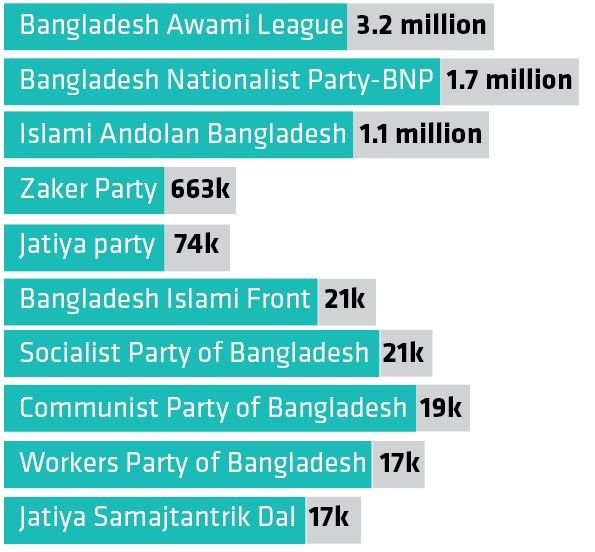
In the Sunni arena, only the Bangladesh Islami Front’s student wing showed its presence on social media in a notable manner. Though the party registered 21k followers on their Facebook page, its students’ wing, Bangadesh Islami Chattrasena, holds a total of 85k followers on their page and seems much more active on social media. Therefore, both the general and religion-based political parties are using social media in an extensive manner to engage people in favour of their campaigns and gain popularity thereby.
SOCIAL MEDIA SITES IN BANGLADESH’S POLITICAL CAMPAIGNS
In Bangladesh, it is rare to see prominent politicians or heads of government using social media during critical moments in the country. While there have been sporadic instances, such as a party leader uploading a video on YouTube to campaign for their candidate in the last city corporation election, these are few and far between. The major political parties in the country have opened social media pages in a haphazard manner, which lack regular updates on their activities and purposes.
Despite the enthusiasm for social media among the younger supporters of political parties, the party veterans, stalwarts, policymakers, and bureaucracy appear to be either computer-illiterate or unable to make use of email or web browsing. The parties in Bangladesh use social media extensively before the election to promote their candidates and cast people’s attraction towards them. This kind of activity has been seen in recent elections as well. Campaigners posted lots of videos, photos, and status updates to promote their candidates. Posting documentaries and showing what they will do after getting elected through video becomes a smart way to present these candidates.
Political parties are in fact using these social media sites to undermine other candidates at the same time. As technology is opening the privacy level in a broader sense, people are now bringing out scandals involving political leaders or their deeds that are condemnable to others and posting those on social media, too, to knock them off the field. People are also expressing their dissatisfaction using these media regarding the elections. But after the incorporation of the Digital Security Act, people are now becoming more sensitive when using words on social media sites, which is lowering the possibility of promoting hatred on these sites as well.
In particular, Facebook has become an ideal platform for election campaigning, with an estimated 10.8 million users in Bangladesh. Candidates for Parliament, mayoral positions, ward councillors, and union parishad (UP) members have all used social media to engage voters and gain support. Digital election campaigns have also enabled candidates to track potential voters’ views and preferences in real-time and tailor their campaign messages accordingly.
HOW MIGHT USAGE OF SOCIAL MEDIA CHANGE IN NEAR FUTURE?
Social media platforms can have different effects on a state’s political system depending on the type of regime and actors involved. Social media can destabilise weak authoritarian regimes by facilitating the coordination of domestic opposition and grassroots movements, leading to regime change or failed state scenarios. In weak democratic countries, the use of social media for disseminating fake news and disinformation can have a radicalising effect, leading to the rise of populist and anti-establishment candidates and potentially diminishing democratic institutions. In recent years, social media platforms have gained significant power through the collection and utilisation of vast amounts of data. This power, which British scholar Susan Strange referred to as “knowledge power,” encompasses the dissemination and restriction of beliefs, ideas, and knowledge. The ability to withhold knowledge can be just as impactful as the power to share it.
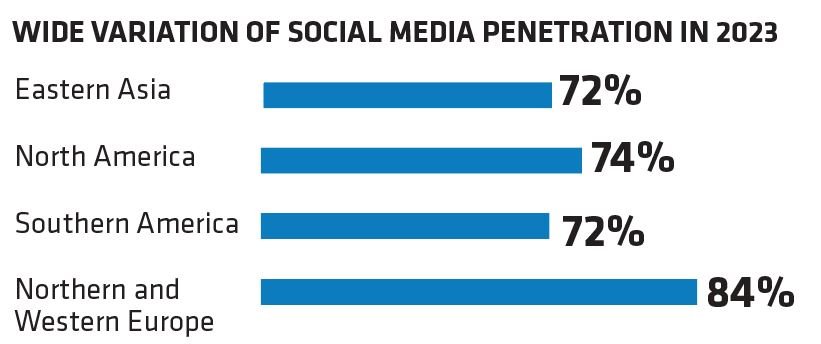
The knowledge power of social media takes various forms, as exemplified by Facebook, which possesses more personal data than even governments do. Google discovered in 2002 that it could use the data it had collected to profile users based on their interests and characteristics and then match ads to individuals. Over the years, these companies have sold more ads by reducing user privacy and increasing access to users’ data. In the race for “surveillance capitalism” revenue, the advantage goes to those firms that can accumulate vast and diverse data streams. As such, social media platforms are expanding both the scope and depth of surveillance, moving from the virtual world into the real world, such as automobile dashboards, and collecting information on individuals’ personalities, moods, and emotions.
The knowledge power of social media platforms can influence political discourse and decisions in the future too and for sure in a more constructive manner as technology improves day by day. Social media’s ability to manipulate and influence public opinion has already been demonstrated in several high-profile cases. The Cambridge Analytica scandal, as mentioned in the previous Brexit issue, revealed how Facebook data was misused to influence the 2016 US Presidential Election. The knowledge power of social media platforms also poses a threat to individual privacy rights and could lead to authoritarian regimes exploiting data to suppress dissent and control their citizens. Simultaneously, the future of global politics will take shape as the best innovation of the century, artificial intelligence based chatbots like ChatGPT, have arrived. This technology, in its reshaped and more efficient version, will help politicians gain data, programme facts, and analyse anything that they need. It will help create promotional material in faster and more efficient manner. Moreover, it will also help them come up with solutions for affecting human minds in a broader range, as technologies can play a crucial role in understanding human behaviour and showing plans according to that.
Many people in Bangladesh have been adopting the virtual realm as a parallel discursive zone since the 2010s, causing mainstream media to lose its battle for political power. However, there is still an on-going debate about whether digital media is minimising the appeal of traditional media. While some theorists are yet to be convinced, others argue that digital media is transforming the political landscape in Bangladesh by providing a more democratic and pluralistic public sphere.
Apart from the debate, the current trend in Bangladesh’s political culture suggests that digital media will be a decisive player in national as well as local politics. By providing various political participants with scopes to engage in politics, digital media is pluralising and democratising politics to a greater degree. Nonetheless, it could reshape politics either by enhancing the quality or by creating discontent in the political sphere.

